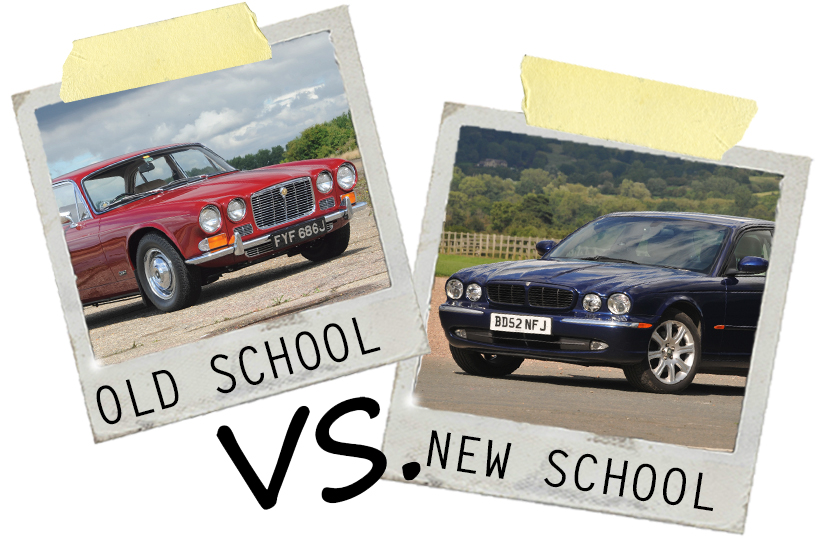Welcome to Old School vs New School where we visit the controversial subject of traditional classics compared to their more youthful equivalents. This time, the Jaguar XJ Series vs Jaguar XJ X350…
Just as today’s paper is tomorrow’s chip wrappers, so each modern classic will eventually take its accepted place in the line-up of cherished classics at a car show of the future and we’ve picked another selection we reckon offer a good illustration of the changing tastes.

OLD SCHOOL: JAGUAR XJ SERIES 1
TECH SPEC
Engine: 3532cc
Power: 165bhp
Top Speed: 106mph
Fuel consumption: 15mpg
Gearbox: five-speed manual
We covered all eight generations in Jaguar XJ Complete Guide in our celebration of the model’s half-century and it’s obvious that the model is no less significant to the Jaguar brand’s history than the E-Type, D-Type or XK120.
For one thing, the all-new XJ in 1968 effectively replaced the entire Jaguar saloon range of the time and then went on to carry the brand through the dark days of the BL period and into a new privatized era, shrugging off quality issues and changing fashions along the way. I’ve been lucky enough to sample both Mk1 and Mk2 Jaguar saloon recently as well as the S-Type and the short-lived 420 and they’re all great cars in their own way but when you step from the Mk2-based cars into even the earliest of the XJs it’s obvious that the newer car is from a different era.
Curiously there was no single feature of the XJ which was entirely brand new, but by combining its accumulated expertise in monocoque bodyshells with careful attention to refinement the firm was able to produce something truly groundbreaking.
We’ve covered the Bentley Turbo R elsewhere in this feature and it’s fair to say that the dominant reason Crewe decided to bolt a blower to the side of its big V8 was that Jaguar’s V12 was able to eclipse the Rolls- Royce in performance terms, while the XJ was also a close match when it came to refinement, all at a fraction of the price, even in range-topping
WHAT’S THE APPEAL?
The Series 1 XJ, whether in straightsix XK-engined form or with the legendary V12 under the fluted bonnet is a great way to travel and combines all the elegance of the ’60s Jaguars with much more modern driving manners.
The style of the Series 1 is very much Lyons’ original vision, something which was compromised for the Series 2 when it was restyled to suit US bumper height regulations and was then further modified with Pininfarina’s involvement for the Series 3. The Italian restyle pulled off a neat trick of making the car seem sleeker while actually raising the roofline, but you just know Lyons preferred his own original. As an aside, Jaguar itself admits that the big grille of the current XJ is a clear reference to the Series 1.
OWNING THEM
Assuming you’ve bought a good example in the first place, Series 1 ownership should be pretty painless – although if you’re running a carb-fed XJ12 then expect regular episodes of despair at the filling station.
Any Series 1 is getting on in years now though, so it’s crucial to keep an eye on the bodywork. The XK engine is regarded as robust but can still get expensive when problems like failed head gaskets arise, although with the proper maintenance this really shouldn’t become an issue.
As far as practicality goes, the XJ will fit into a decent-sized domestic garage and in contrast with a modern 7-Series or S-Class is a much more manageable prospect. Parts support is excellent, helped by the parts commonality with so many other XKpowered models and there’s little you can’t get for the mechanical side of things – although some body panels are hard to source.
They are big, heavy cars though so if you’re planning on doing much DIY maintenance then make sure your jack and axle stands are up to scratch.
BUYING THEM
• Check the sills, the area where the rear radius arms mount to the floorpan and the rear jacking points. Also the seam between the floorpan and the transmission tunnel which can be tricky to repair neatly.
• Wings are bolt-on but good used parts are rare. Door bottoms will rot out too. Rear arches can rot out but repair panels are available.
• Front crossmembers can rot.
• The cost of rechroming can mount up.
• The XK engines are pretty tough but the timing chains can get noisy. Lack of anti-freeze can result in internal corrosion.
• The four A-shaped mounts locating the rear suspension to the body can perish and handling suffers. Rear radius arms can rot and their Metalastik bushes perish.
• Inboard rear brakes make disc/pad changes hard work and leaking diff can cover the brakes in oil.
VALUES
The Series 1 was the first of the XJs to rise significantly in value and the early short-wheelbase cars are rare and sought-after, especially if you come across a manual car. Budget on £15,000 for a nice series 1, with expensively restored or very original cars up to the £30,000 mark and projects from around £4000.
Insuring them
To cover a 1971 Jaguar XJ6 worth £17,000 you’re looking at £85 with £100 accidental damage, fire and theft excess through Adrian Flux.
Quotes are based on a 45-year-old male, second vehicle. The car is garaged, covers 3000 miles a year and lives in an SP2 postcode. He has no claims or convictions, is a club member, and is employed as a marketing manager. Comprehensive cover quotes were supplied by Adrian Flux and include free legal cover and optional agreed value. You can get your own quote at Adrian Flux or on 0800 085 5000…

NEW SCHOOL: JAGUAR XJ X350
TECH SPEC
Engine: 4196cc V8
Power: 300bhp
Top speed: 155mph
Fuel consumption: 30mpg
Gearbox: six-speed auto
When it comes to the X350, any reference to the BL days is best forgotten: with Ford’s money behind it, Jaguar created a car which needed no excuses making for it and boasted technology the equal of any of the German makers.
Development began in parallel with the Mondeo-based X-Type and the brief requiring increased interior space meant it would need to be larger than its XJ40-based predecessor, which required a wheelbase stretch to 3034mm but in order to avoid the weight ballooning as a result, the decision was taken to go with a lightweight aluminium construction.
Unlike Audi and Honda’s use of extruded spaceframes, Jaguar went for a bonded and riveted construction which the firm still uses today, involving the high-tech glue being cured by the heat of the paint oven.
It wasn’t all good though. The lower strength compared to steel was a factor heavily influencing the appearance of the new car, with designer Fergus Pollock pointing out that the need to retain torsional stiffness resulted in larger than average pillars and a high waistline.
In his fascinating book Jaguar Design, former Jaguar designer Nick Hull also points out the rising feature line in the lower half of the rear doors which apparently helps to visually slim the sides of the car.
As for the look of the car, extensive customer clinics held by Ford saw the adoption of the familiar Jaguar face with the sculpted four-lamp front end. The launch range included the 3-litre V6 good for 240 bhp, the 3.5-litre V8 in 262 bhp flavour and the 4.2-litre V8 in both 300 bhp and supercharged 400 bhp form plus the 2.7-litre twin-turbo V6 in the TDVi good for 204 bhp.
Underneath was found standard air suspension at all four corners and in conjunction with the car’s lightweight build this made it a more capable handler than its size would suggest.
WHAT’S THE APPEAL?
With nice examples available for just £3000 upwards, the X350 is a tremendous thing and although it may lack the accepted classic status of the Series 1, it’s a genuinely characterful alternative to any of the German brands. Much like the XK featured elsewhere, the X350 isn’t only a modern classic but appeals as an affordable way into a top-flight modern luxury saloon.
The V6 models are good enough, but the real gem is the normally aspirated V8 which sports a full 300bhp and is a genuinely quick car with enough shove to push you back into the seat on kickdown and refinement which would shame a new 5-Series.
It’s also a genuinely elegant car, that traditional Jaguar face giving it a style lacking in most of its contemporaries. It’s the sort of thing which has your non-car neighbours commenting approvingly along the lines of “what a nice car that is…”
OWNING THEM
With all-round air suspension you didn’t expect it to be all plain sailing, did you? Having said that, most problems can be sorted relatively easily thanks to the availability of both used and aftermarket parts. Height sensors are a common issue with the suspension but simple enough to change, as is the main compressor pump and if the worst happens then a used strut is under £200.
Expect to replace the odd suspension bush every so often to keep it feeling sharp and elsewhere, the door locks and window regulators are common failures but again are all DIY jobs.
Possibly the best part of the whole thing is that with gentle driving, your 300bhp V8 can return an honest 32mpg. We know because we’ve got one and we’ve done it.
BUYING THEM
• The V8 is reliable with only the odd sensor requiring replacement in most cases.
• Diesels suffer patchy reliability and need a good history.
• The Ford-derived V6 is reliable although it can leak oil from crank seal and sump. Oxygen sensors need frequent replacement.
• Gearbox oil leaks can be cured when the oil and filter are changed.
• Electric parking brake needs diagnostic tool for pad changes.
• ABS problems can mean a new halfshaft when the sensor ring corrodes.
• Air suspension issue generally involve height sensors.
VALUES
As with many modern classics of this era, prices are all over the place with the newer cars still depreciating and the older or more miley cars near the bottom of the curve. The V6 models are your entry ticket: think just under £2000 for a 3.0 SE showing 165,000 miles, rising to around £4000 for a nicely specced example showing 80,000 miles.
You can expect to pick up an early 4.2-litre V8 for around £3000 with a few dashboard warning lights to keep you busy and 100,000 miles showing, rising to £4000 for the nicer cars and £5000 if you want to see fewer than 100,000 miles. The XJR starts at around £5000, with the top whack for pre-facelift cars being around £9000. The diesel starts at around £3000 for miley examples, rising to around £7000 for sub-100k miles and closer to £9000 for the low-mileage examples.
Insuring them
To cover a 2002 Jaguar XJ8 worth £3500 you’re looking at £190 with £200 accidental damage, fire and theft excess through Adrian Flux.
Quotes are based on a 45-year-old male, second vehicle. The car is garaged, covers 3000 miles a year and lives in an SP2 postcode. He has no claims or convictions, is a club member, and is employed as a marketing manager. Comprehensive cover quotes were supplied by Adrian Flux and include free legal cover and optional agreed value.
You can get your own quote at Adrian Flux or on 0800 085 5000.
OLD SCHOOL VS NEW SCHOOL SERIES
Thinking of getting your hands on a modern classic car? Well keep an eye on Classics World for the next of our old school vs new school classics feature, where we will visit the controversial subject of traditional classics compared to their more youthful equivalents.









